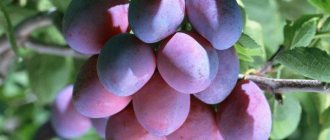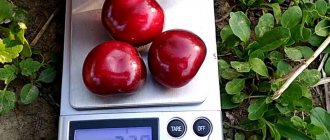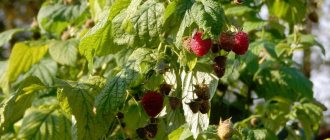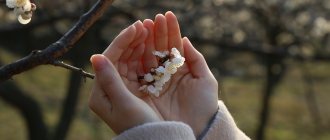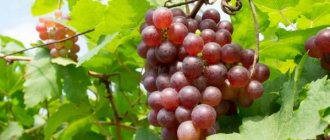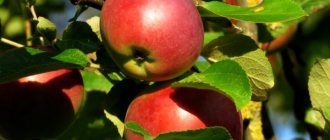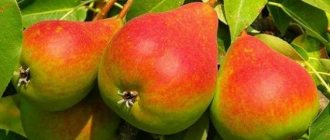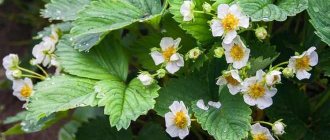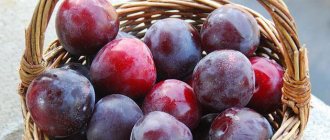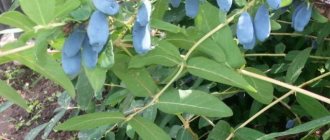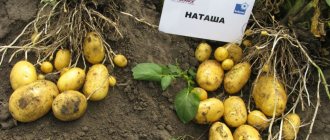History of variety development
The Alyonushka plum is the result of selection by Russian specialists from the All-Russian Research Institute of Fruit Crop Breeding, located in Orel. This variety was obtained by crossing the following plums - Chinese and Red Ball.
Selection work on breeding Alyonushka was carried out in the last quarter of the last century, then tests of a new plum were carried out, and in 2001 Alyonushka was included in the Russian State Register and recommended for cultivation in the Central Black Earth region.
Chinese plum Alyonushka - photo
Plum Alyonushka: description and characteristics of the variety
Chinese plums are not distinguished by the large height of the central trunk, and Alyonushka is no exception - its size is about 2.4 m. It is easier to care for such a fruit tree - prune, spray, and also collect ripe fruits.
The crown is medium dense, its shape is pyramidal. The shoots are straight, without pubescence, the color of the bark is brown with a reddish tint. The foliage is oblong, the tips are rounded, dark emerald color, matte.
Alyonushka plum can be grown in the Central Black Earth region. Gardeners grow this fruit tree on their plots in Voronezh, Kursk and other regions of this region.
Ripe Alyonushka plums have a round shape and large size - the weight of one fruit can reach 60-65 g, but their average weight is no more than 40 g
. The color of the dense, smooth skin is red with a characteristic coating of wax. The juicy and tender pulp of ripe plums is yellow-orange in color, and its taste is sweet with a characteristic sourness. Plums are not prone to cracking, so they tolerate transportation well over different distances and can be stored in the refrigerator for a long time.
Interesting!
The tasting score of ripe Alyonushka plum is 4.6 points, which is a very high value.
The separation of fruits from the petioles is dry, so during transportation no juice is released at the place of separation.
The collected fruits have a universal purpose - they can be eaten fresh, and also used for preservation - the Alyonushka plum makes delicious preserves and jams, as well as compotes. Many people put the harvested crops in the freezer for long-term storage.
Photo of Chinese plum Alyonushka
Frost resistance of Plum Alyonushka is average
, however, the buds can withstand a significant drop in temperature without freezing, so this variety can be grown even in the Urals, where climatic conditions are unpredictable.
Features of culture
The winter hardiness of the tree is average, and the flower buds have high hardiness. The variety is considered relatively resistant to clasterosporia and moniliosis.
The main advantages of the Alyonushka variety:
- commercial qualities and excellent taste of fruits;
- lack of predisposition to fungal diseases.
Flaws:
- high risk of aphids appearing on shoots and leaves;
- in the case of high humidity in autumn and heavy snow in warm winters, the bark at the base of the trunk becomes warmer.
Note: deficiencies can be compensated for by planting conditions. It is recommended to plant on a hill and graft onto a rootstock that is resistant to damping off.
It is not difficult to care for the Alyonushka plum variety. It is necessary to water at intervals of 20 days. Use 15 liters of warm water each time. Afterwards, you need to loosen the soil so that air and moisture can get inside. By removing weeds, you provide space for the development of the root system, which will make the plant stable.
Read more: Duck Star 53: breed description, characteristics, breeding
In spring, remove those shoots and branches that disrupt the structure of the crown. In autumn, cut off all diseased branches. This will allow the plant to survive frost more comfortably. Fertilizing is applied twice a year, 15 liters of solution per plant:
- in the spring, potassium nitrate (40 g per 5 liters of water);
- in autumn superphosphate (30 g per 7 liters of water).
In autumn, it is recommended to add superphosphate under the plum.
Pollinator trees for plum Alyonushka
The Alyonushka plum variety is partially self-fertile, so it can bear fruit even if pollinating trees are not planted nearby. However, in this case the yield will be too low.
In order for the yield to be at the level of the declared indicators, other plum varieties with similar flowering periods are planted nearby.
Of the plum varieties, the best pollinator for Alyonushka will be the Skoroplodnaya variety
. This stone fruit tree is also well pollinated by any varieties of cherry plum.
Alyonushka blooms in the first ten days of May, and ripe fruits can be collected in the second or third ten days of August (depending on the climatic conditions of the growing region).
Varieties of plums!
Plum Morning Plum Study Plum Stanley (Stanley)
Collection and storage
In the first ten days of August, you can harvest plums of the Alyonushka variety. It is not recommended to remove fruits after rain, watering, or early in the morning when there is dew on the plums, but only under dry weather conditions.
The harvested crop cannot be preserved for a long time. Alenka plum is a table variety; it is best to eat it fresh immediately after harvest, and process part of the harvest into homemade preparations for the winter. Since the fruits are suitable for jams and compotes.
Plum Alyonushka embodies the best qualities of famous varieties. Its taste qualities, characterized by a balance of sugar content and acidity, are considered significant, which is why it is in special demand and extremely popular.
Diseases and pests
This variety has excellent immunity, so it is not afraid of monoliosis and hole spotting (klyasterosporiosis), which usually affects other varieties of plum trees.
In spring and early summer, this stone fruit crop can be attacked by aphids. It is quite simple to combat it - you can spray it with garlic infusion, and in case of a large area affected by these pests, it is better to use an insecticide solution for treatment.
Plum tree diseases - how to fight
Watering and fertilizing a fruit-bearing tree
From the moment it begins to bear fruit (in the third year), the plum tree will require additional feeding:
- Nitrogen is introduced from early spring until the start of budding. The simplest thing is to scatter urea over the melting snow (1 tablespoon for every 1 m² of tree trunk circle). When the ground thaws, you can water it with a solution of this fertilizer (1 tablespoon per 10 liters of water) or an infusion of mullein, droppings, nettles, and weeds.
- Foliar application is carried out during flowering with the following preparations: Ovary, Bud, boric acid.
- Complex is necessary in the budding phase and the beginning of flowering. It should contain phosphorus, potassium and microelements; you can buy a ready-made mixture for fruit and berry crops labeled “spring-summer” in the store. Wood ash is good for this period: a glass of 10 liters of water, shake and pour.
- Phosphorus-potassium is needed by plums after fruiting for the growth and strengthening of roots, ripening of wood and buds. Use superphosphate and any potassium salt that does not contain chlorine - scatter 1 tbsp. l. for every square meter of the tree trunk circle or dissolve in 10 liters of water and water.
Read more: Growing plums: how to propagate plums by layering, cuttings and root shoots
Combine all fertilizing with watering. The rate of liquid fertilizing is 1 bucket/m², simple watering with clean water is 3 buckets/m². In addition, plum trees need moisture during the growth of the ovaries, when their size becomes larger than a pea, and in October they do moisture-recharging watering. As a result, during the dry season the tree will have to be watered a maximum of 5 times, and regular rains can save you from this event altogether.
Advantages of the variety
The Alyonushka plum has a number of advantages that should be discussed:
- dry separation of fruits from petioles;
- excellent presentation and good taste of the collected fruits;
- during flowering, this plum looks very beautiful;
- collected plums have a universal purpose.
However, this stone fruit tree also has a number of disadvantages:
- often affected by aphids;
- during periods of rain or melting snow, the bark at the base of the trunk may rot.
How to properly plant Alyonushka plum
Planting and caring for the Chinese plum Alyonushka are somewhat different from similar procedures when growing conventional varieties of stone fruit crops. But by following all the rules, gardeners regularly receive high yields from Alyonushka.
Chinese plum varieties should be planted in open ground only in autumn
. The root system of such a tree in the ground can withstand cold weather well, and before the onset of frost the plant manages to acclimatize, does not freeze out during the winter period, and with the arrival of spring actively grows.
Important!
The Alyonushka plum planting time should be calculated in such a way that at least 40-50 days remain before the onset of cold weather.
This overseas variety is planted only in a sunny, open place located at some elevation. The proximity of groundwater to the surface of the earth can be detrimental to this stone fruit crop, so it should not be planted in low-lying areas. In such places, melt water collects in the spring, and it is also colder there than at higher elevations. When planted on hills, the root collar of the tree will not be subject to rotting during rainy periods or massive snow melting.
Photo of plum variety Alyonushka
Next to the Alyonushka plum you can plant black currants or gooseberries
. But it is strictly not recommended to plant Alyonushka next to tall fruit trees that will shade it.
These include:
When buying a Chinese plum seedling Alyonushka, you need to pay attention to the following:
- there should be no visible signs of damage from pests or diseases (spots, cobwebs, various growths) on the bark and shoots;
- You need to buy two-year-old seedlings; at an older age, trees do not take root well in a new place and often die;
- the root system must also be healthy, without damage or dry parts. The more roots it has, the better.
Pruning of shoots and roots when planting in the autumn cannot be done - this worsens the process of acclimatization of the seedling.
10-12 days before the intended planting of the Alyonushka plum, planting holes are dug with a diameter of 40 cm and a depth of 50 cm. A peg is driven in near the center of the hole to which the seedling will be tied.
Planting and fertilizing plums
Alyonushka plum seedlings are placed in the center of the hole, the roots are straightened, and the tree is tied to a peg. Purchased trees with a closed root system are planted together with a lump of earth.
Fill the hole with a nutrient substrate and compact it so that no air remains near the roots. Up to 15-20 liters of water are poured under each tree, and the trunk circle is mulched.
Varieties of berry bushes:
Gooseberry Date Blackberry Black satin Honeysuckle variety Morena
Landing rules
When planting the Alyonushka variety of plum seedlings, you should take into account some rules, which will be discussed below.
Choice of dates and site
First of all, you need to decide on the landing site. This plum variety loves sunny and windless places, for example, a protected area near a fence. Low-lying areas are not suitable for planting, as there is a high risk of rotting of the lower part of the trunk. The groundwater level is allowed no higher than 1.5 meters.
Alyonushka seedlings take root well in warm, windless weather. For this reason, it is recommended to plant them in mid or late spring.
Preparing the planting hole and seedling
The soil for planting should be light, loose, fertile. The area intended for cultivation must be prepared a month before planting: dig up, remove weeds. If the soil is highly acidic, it is necessary to add an ash solution at the rate of 300 g per 10 liters of water. Slaked lime copes well with acidity.
The planting hole should be dug immediately before planting the seedling. The optimal size of the hole is 0.5 m in diameter and the same in depth. If fertilizers were applied in the fall, no additional fertilizing is required when planting in the spring.
Planting technology
Correct landing is carried out using the following technology:
- Carefully straighten the root system of the seedling and lower it into the hole.
- Holding the tree in place, bury the roots and pat down the soil around the trunk.
- You should act carefully, trying not to damage the root system.
- The root collar should be 5-6 cm above the ground level.
- Form a small mound around the bottom of the trunk and fill with 1 bucket of water.
- Tie the tree to a stake.
See also
Description and characteristics of the Candy plum variety, pollinators
Read
Before purchasing a seedling, you should pay attention to its root system, trunk and trunk. They must be undamaged.
Further care for plum Alyonushka
Further care for this fruit tree consists of watering (at least 4 per season), loosening the trunk circles, removing weeds and preparing for winter.
During dry periods, the amount of watering is increased, and in rainy seasons you should not add moisture to the soil - you can provoke the development of root rot.
Rules for fertilizing plum Alyonushka
Plum Alyonushka responds very well to the application of fertilizers to the tree trunk. In the first two seasons after planting, it is necessary to fertilize at least once a month, alternating the application of organic matter and complex mineral fertilizers. In spring, nitrogen-containing fertilizer should be applied to activate the growth of shoots and green mass.
In the future, you can fertilize the Alyonushka plum twice a season: in the spring, apply fertilizers containing nitrogen to the tree trunk circle, and in the fall - superphosphate and any potassium salt (not containing chlorine!).
Pruning plum trees of the Alyonushka variety
In the first few years, it is not necessary to prune the Alyonushka plum; only frozen or damaged branches are removed in the spring.
Formative pruning of the crown begins when this stone fruit crop is 5 years old.
How to properly prune plums (stone fruits)
Features of growing Chinese plum
Cultivation and care of Chinese plums are almost identical to the cultivation of local varieties.
But there are certain points in growing a fruit plant:
- Floor. Plums readily grow on chernozems, woody-gray soils, loamy soils with a neutral or alkaline environment and a lot of calcium. The groundwater level should be below 1.5 meters from the soil surface.
- Landing place. Chinese plum loves sunny, spacious, but draft-free places. A suitable place for planting is upland; planting the plant in lowlands is strictly prohibited.
- Landing. It is better to plant healthy trees in the spring, which are cut down to 60% of the original height to ensure vigorous growth and adaptation to new growth conditions. The planting pit usually contains 10 liters of mature manure, 50-60 grams of potassium salt, 250-300 grams of superphosphate. To seal up moisture, the soil in the stem circle is sprinkled with sawdust or peat.
- I'm eating. In the year of planting there is no need to apply fertilizers, and next year watering with a solution of nitrogen fertilizers will be very useful. Trees that have entered the fruiting phase are fed for the first time before flowering (60 grams of potassium sulfate and urea are added to 10 liters of water). The next fertilization occurs at the stage of fruit ripening. The last application of fertilizer occurs after harvesting.
Instructions for the use of drops and nasal spray based on cyclamen root for the treatment of sinusitis.
Watering. Plum trees are water-loving plants, so they are watered regularly and systematically. Particular attention is paid to moistening the soil in the dry season, when it is buried to a depth of at least 40 cm and then mulched. Pests. (Read more about pests and diseases of plums here) Plum fertilizer is dangerous and the main enemy of plum fruits. To destroy them, pheromone traps are used every 14 days and the trees are sprayed with chemical and viral preparations. Pesticide treatment is stopped 30 days before harvest.
Although the Chinese plum is considered a guest in our region, it should be treated with due care.
The undoubted advantages of this variety - early grounding, high frost resistance, relatively high yield - lead not only to increased interest among gardeners, but also to the desire to have a beautiful oriental plum in their landscape. And the rich and luminous flower allows the use of miniature trees in landscape design.
Chinese plum is a promising species used by breeders in scientific research to breed and select new varieties.
In this video you can learn how to properly plant and fertilize a plum:
Page 3
Plum white honey is the most delicious and sweet variety.
Although it is called white plum, it is called yellow plum because of its yellow skin and flesh.
So, what is this variety and how to grow it?
Let's look at the full description of white honey plum.
